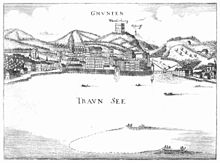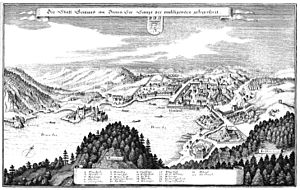Wunderburg (Gmunden)
| Wunderburg (Gmunden) | ||
|---|---|---|
|
City of Gmunden after an engraving by Matthaeus Merian (1656) |
||
| Alternative name (s): | Guglberg | |
| Creation time : | 1324 (first documented mention) | |
| Castle type : | Hilltop castle | |
| Conservation status: | Burgstall | |
| Standing position : | princely castle | |
| Place: | Gmunden municipality | |
| Geographical location | 47 ° 55 '6.2 " N , 13 ° 47' 57.6" E | |
| Height: | 464 m | |
|
|
||
The Wunderburg , also called Guglberg , is an abandoned hilltop castle at 464 m above sea level. NN in the municipality of Gmunden in the Gmunden district of Upper Austria . On an engraving by Matthaeus Merian from (1656) the tower on the Gugelberg (object no. 11) is still drawn; The wonder castle can also be seen well on an engraving by Georg Matthäus Vischer from 1674, which depicts Mühlwang Castle .
history
The "Vest zu Gmunden" is mentioned as early as 1324. In the following there is always talk of a tower that is administered by carers . Mathes der Schuler or Chunrat der Steger (1377) are proven here. The latter is named as the carer on the Gugelperg in several documents from the Niedernburg monastery in Passau. The salt minister Steffan der Krafft redeemed in 1391 "the tower called the Guglperg located ze Gmunden" from Chunrat Steger and is enfeoffed by the dukes Wilhelm and Albrecht. The astronomer and mathematician Johannes von Gmunden , probably a member of the Krafft family, also lived at the Wunderburg. In 1448 Pernhart Prawn took charge of the heirs of Krafft. In 1482 Siegmund Vorster owned the castle; He was married to the widow of the chessman von Ebenzweier , Margaretha († 1483).
Emperor Maximilian I had an arsenal set up in the wonder castle. The upper third of the tower was demolished in 1619 and the rest was transformed into a small fortress. In 1708 the castle was downsized again because the building material was used to build the wholesale trade office building. In 1747 "old walls" could still be seen on the Guglberg and in 1825 some foundation walls.
The name Wunderburg also comes from "Wunnen" = flower bush, meadow hill.

Wonder castle today
The Wunderburg stood on the Guglberg in the immediate vicinity of an inn that was formerly a hunting lodge of Emperor Franz Josef I (house number 3). The Guglberg itself served as a shooting range and amusement spot for the population as early as the 17th century. In 1861 the place was bought by the municipality of Gmunden; In 1873 it passed to the brewery owner Leopold Braun. The house built there came from this in 1904 to the German gymnastics club; the building was demolished in 1961, the remains of the former wonder castle were removed in 1962 and a new clubhouse (Turnverein Gmunden 1861) was built
literature
- Norbert Grabherr : Castles and palaces in Upper Austria. A guide for castle hikers and friends of home . 3. Edition. Oberösterreichischer Landesverlag, Linz 1976, ISBN 3-85214-157-5 .
- Oskar Hille: Castles and palaces in Upper Austria then and now . Verlag Ferdinand Berger & Sons, Horn 1975, ISBN 3-85028-023-3 .
- Ferdinand Krackowizer: The castle stable on the Guglberg. Self-published by the German Gymnastics Club in Gmunden, Gmunden 1925.
Individual evidence
- ↑ Documents of the Niedernburg zu Passau ( page no longer available , search in web archives ) Info: The link was automatically marked as defective. Please check the link according to the instructions and then remove this notice.
- ↑ Johann Georg Adam von Hoheneck: The praiseworthy gentlemen gentlemen Stands Deß Ertz-Herzogthumb Austria whether the ...
- ↑ Ignaz Gielge: Topographical-historical description of all cities, markets ..., Volume 1.

